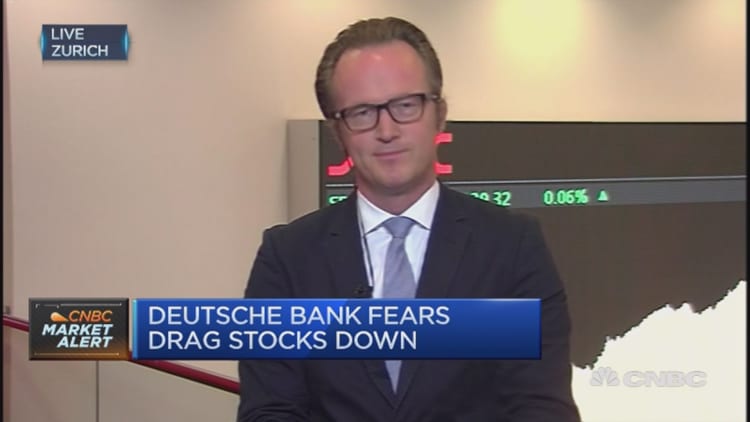Rumors have swirled this week about hedge funds bailing on Deutsche Bank amid market-moving fears that the bank is in financial trouble, but there was a multibillion-dollar move by investors away from Deutsche Bank in September that easy-to-access, reliable numbers can confirm. It's just not the exodus traders shorting shares of the German bank have been looking for.
More than $2 billion was pulled from Deutsche Bank's X-trackers MSCI EAFE Currency-Hedged Equity Fund (DBEF) in September, according to data from XTF.com as of Friday morning, the last day of the month. It was by far the biggest move out of any ETF in the past month — the second-biggest outflow from a single ETF in September was $600 million less.
After a tumultuous week, Deutsche Bank shares rallied on Friday by 14 percent.
The move has nothing to do with Deutsche Bank's financial stability, but the German banking giant may serve as a microcosm of current investor sentiment on developed markets outside the United States and questions about the stability of Europe's market, a concern Allianz's chief economic advisor, Mohamed El-Erian, pointed to in an interview with CNBC on Friday. The September outflows were part of a continued trend away from European stocks in particular.
Two iShares developed markets ETFs — iShares MSCI EAFE (EFA) and iShares Currency Hedged MSCI EAFE (HEFA) — saw a combined $1.2 billion pulled in in September by ETF traders and investors. Two of the other top-10 ETFs experiencing outflows in September were Europe funds — iShares MSCI EMU (EZU) and Vanguard Europe (VGK) — which saw $771 million and $647 million of outflows.
That means, in all, five of the top 10 ETF losers in September were developed markets, ex-US or Europe-specific bets.

Investors looking outside the United States have been leapfrogging over the developed markets and into emerging economies for much of 2016, and that continued in September. "We've seen strong EM flows through the quarter. Investors want international exposure but, for the most part, don't want to be exposed to Europe," said Todd Rosenbluth, director of mutual fund and ETF research at S&P Global Market Intelligence.
Igor Zilberman, head of research at XTF.com, said the money leaving the DB X-trackers ETF represents trader sentiment more so than long-term investor sentiment, as buy-and-hold investors will always have some exposure to developed markets, ex-U.S.
It's the traders who move in and out of the developed markets and, in particular, the currency-hedged products, who have been bailing on Europe, as well as Japan, this year. According to XTF.com data, year-to-date currency-hedged products have lost $20 billion, with the ETF company that benefited the most from the trend's popularity now getting hit hard — WisdomTree Investments' currency hedged Europe ETF (HEDJ) has seen $7 billion in outflows this year, according to XTF.com data. "Europe is the biggest loser," Zilberman said.
Neena Mishra, director of ETF research at Zacks Investment Research, said the bail-on-Europe trend has now reached near-$100 billion in all and 34-consecutive weeks of outflows for European equity funds — including all funds not just ETFs — citing the Financial Times. She attributed it to concerns about the European Central Bank's ability to prop up the region any longer and, specifically, the disappointment among investors after the ECB surprised the markets by not offering a more interventionist stance at its latest meeting — it did not extent the deadline for its bond-buying program beyond March 2017.
There prevailing gloom and doom throughout 2016 on developed markets outside the United States is most acutely focused on Europe: the Vanguard FTSE Developed Markets ETF (VEA) is actually the fourth best for inflows this year and was again in the top 10 for inflows in September. VEA does have less exposure to Europe than the MSCI EAFE-based ETFs — 53 percent for the FTSE index versus 61 percent for MSCI EAFE, and slightly less exposure to Japan. But the significant outflows are out of Europe specifically, at $21 billion year-to-date. Developed markets ex-U.S. overall have managed a year-to-date inflow that remains positive, at $2 billion, according to XTF.com data.
Overall, the September investing trends showed a lack of new, notable bets, which may indicate that in the run-up to the U.S. presidential election and continued waiting on the Federal Reserve to make a move on interest rates, investors are uncertain.
"People don't know where to invest and are asking themselves, 'Do I stay in cash?" Mishra said. "Maybe the election and a hike in December will end the uncertainty," she said. For the most part, "people are staying invested but not making big new bets," she added.
Top 10 in September for ETF outflows
| ETF | Sept. outflows | QTD flows | YTD flows |
|---|---|---|---|
| DB X-trackers MSCI EAFE | ($2.1B) | ($3.5B) | ($4.8B) |
| PowerShares QQQ | ($1.5B) | $1.3B | ($5B) |
| Financial Select Sector SPDR | ($912M) | ($802M) | ($4.2B) |
| Vanguard Financials | ($880M) | ($289M) | ($288M) |
| iShares MSCI EMU | ($772M) | ($2.7B) | ($6.3B) |
| iShares MSCI EAFE | ($673M) | ($1.1B) | ($502M) |
| Vanguard FTSE Europe | ($648M) | ($2.2B) | ($3.3B) |
| iShares 20+ Year Treasury | ($528M) | ($1.6B) | $95M |
| PowerShares S&P 500 Low Vol | ($486M) | ($310M) | $892M |
| iShares Currency Hedged MSCI EAFE | ($479M) | ($623M) | ($410M) |
Source: XTF.com
Top 10 year-to-date ETF inflows
| ETF | YTD flows |
|---|---|
| SPDR Gold | $12.2B |
| iShares Core U.S. Aggregate Bond | $9.7B |
| Vanguard S&P 500 | $8.2B |
| Vanguard FTSE Developed Markets | $7.2B |
| iShares iBoxx Inv. Grade Corp. Bond | $7B |
| iShares MSCI Emerging Markets | $6.6B |
| iShares Edge MSCI Min Vol | $6.3B |
| SPDR S&P 500 | $6.1B |
| iShares Core MSCI Emerging Markets | $5.5B |
| iShares Core S&P 500 | $5B |
Source: XTF.com





